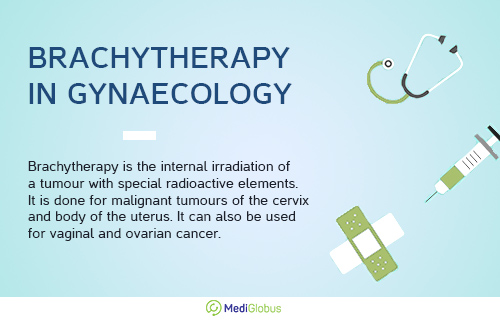Brachytherapy involves internal irradiation of a malignant tumour. With this method it is possible to target cancer cells more precisely and minimise the negative effects of radiation on the body. Read more about brachytherapy in gynaecology, the results it produces and clinic recommendations in our article.
Listen to the article:
When is brachytherapy used in gynaecology?

Internal brachytherapy can be used to irradiate certain gynaecological oncopathologies. According to the National Library of Medicine, the procedure is usually indicated for both radical and adjuvant (post-operative) treatment of vaginal, cervical and endometrial cancers.
This type of radiotherapy allows radiation to precisely target the malignant cells. The radiation rays are practically incapable of reaching tissues outside the tumour. This is important in the treatment of recurrent forms of oncology, particularly ovarian cancer. As patients with such diseases have usually already undergone more than one surgery, the anatomical structure of this area has changed greatly.
Recurrent ovarian tumours can involve vessels, urethra, vagina, rectum. Removal of these tumours is not possible, but treatment with brachytherapy is.
To find out more information about brachytherapy treatment abroad, click on the button below and fill in the feedback form. We shall try to answer all your medical questions.
Effectiveness of brachytherapy for malignant gynaecological pathologies
According to the peer-reviewed journal Oncotarget and the US National Library of Medicine, the one-, two-, and three-year survival prognosis for recurrent ovarian cancer after brachytherapy are 79,3%, 63,0%, and 52,5%, respectively.
According to the American Brachytherapy Society, the overall 5-year survival rate for stage 1-4 cervical cancer after brachytherapy and distant radiation therapy is 68,5%.
According to a study published in Advances in Radiation Oncology, patients with stage 1-2 endometrial cancer who underwent brachytherapy showed a 91% overall survival and 85% recurrence-free survival. According to the National Library of Medicine, in stage 3 endometrial cancer, approximately 69% of patients who received brachytherapy in combination with other treatments passed the 5-year survival threshold.
How does brachytherapy work in the treatment of body and cervical cancer?
Brachytherapy involves injecting radioactive elements into the tumour or the area close to it. It can be carried out without anaesthesia or under general or local anaesthesia. Low or high doses of radiation are used to perform the procedure:
Low-dose brachytherapy lasts for several days. During this time, the patient stays in a special box under the supervision of the medical team. The radioactive substance applicator is inserted into the vagina and stays there to irradiate the tumour for about 1-4 days.
High-dose brachytherapy is performed on an outpatient basis. In order to achieve the maximum effect, 3-5 sessions are usually required at intervals of at least a week. During each treatment, radioactive material is injected for around 10-20 minutes and then removed.
For brachytherapy in patients who have had a hysterectomy (removal of the uterus), a special tube similar to a vaginal ultrasound probe is used. Radioactive material is placed in it and inserted into the vagina for a period of time. It is a painless procedure that does not require a long hospital stay and anaesthesia.
In brachytherapy for women who have a uterus, the radioactive material can be placed in a small metal tube called a tandem. It is inserted into the uterus along with small round metal applicators (ovoids) placed next to the cervix. Alternatively, round disc-like holders can be used instead of applicators. The device with the radioactive elements is left in the cervix for a few minutes and then removed.
Complications after brachytherapy for gynaecological cancer
Brachytherapy has fewer risks of side-effects, including serious ones, than external radiation. However, it is often prescribed together with conventional radiotherapy. It is therefore not always possible to determine exactly what is causing the complications. Patients may experience cramps and soreness in the lower abdomen, vaginal irritation and bloody discharge, bowel and bladder disorders, nausea and fatigue after the procedure. Some women may also experience early menopause.
Is radiation therapy necessary after removal of the uterus for cancer?
Conventional radiotherapy, like brachytherapy, can be used to reduce the risk of recurrence after removal of the uterus in gynaecological malignancies, including endometrial cancer of the upper vagina. Radiation is also used for advanced cancer of the female organs when neighbouring lymph nodes or other structures are affected. In this case, radiotherapy is often combined with chemotherapy.
Stories of people who have defeated cervical cancer

Cervical cancer is not a death sentence. This is especially true for people who have sought timely medical care and undergone comprehensive treatment. Jasmine is one of such patients. At the age of 26, she found out she had stage 2b cervical cancer. She did not give up and started fighting the disease. She was given 25 radiotherapy sessions, 5 chemotherapy sessions and 3 brachytherapy sessions.
As she already had 2 children, she did not do anything about the fact that she would probably not be able to get pregnant after the treatment. The woman decided to put all her energy into confronting the cancer.
Jasmine found the first course of radiotherapy for cervical cancer mentally difficult. She had to go to hospital almost every day for five weeks. Surprisingly, however, the radiation and chemo did not cause any critical complications for the woman. She felt tired. She also had some bowel and bladder problems. But overall, her general well-being was relatively normal.
After a while, Jasmine had brachytherapy. She had never heard of this method before, so she was a little worried. However, it didn’t turn out to be such a bad thing. The procedure was done under general anaesthesia. A special catheter with radioactive elements was inserted into the uterus to target the affected area.
She received her last brachytherapy treatment in January 2020 and a PET scan in April that year showed no signs of cancer.
Story posted on Jo’s Cervical Cancer Trust
Can cervical cancer be cured with brachytherapy?
When answering this question, it is worth bearing in mind that the fight against the disease must be comprehensive. Yes, brachytherapy can destroy residual cancer cells and minimise the risk of cancer recurrence, but in most cases, this type of treatment is used in combination with surgery, external radiotherapy and/or chemotherapy. It should also be remembered that the earlier the pathology is detected, the higher the chances of remission.
Where can I get brachytherapy abroad?
Medipol Hospital
Sheba Hospital
SoonChunHyang Hospital
Vivantes Medical Centre
Quironsalud Torrevieja Hospital
Severance Hospital
Summary
Brachytherapy is the internal irradiation of a tumour with special radioactive elements. It is carried out for malignant tumours of the cervix and body of the uterus. It can also be used for vaginal and ovarian cancer.
Brachytherapy can be carried out with high or low doses. The radioactive substance is injected using a special catheter with an applicator or a tandem with metal holders. It is left in the body for 10-20 minutes or for 1-4 days. The duration, intensity and number of sessions are calculated on a case-by-case basis.
The effectiveness of brachytherapy treatment for female organ cancer depends on the type and severity of the pathology. The overall survival rate of women with cervical cancer after internal or external radiotherapy is 68,5%. The one-, two- and three-year survival rates for recurrent ovarian cancer after brachytherapy are 79,3%, 63,0% and 52,5%, respectively.
Patients can go to the following clinics for treatment of gynaecological oncology with brachytherapy: Hisar, Medipol, Liv, Sheba, Assuta, SoonChunHyang, Cologne University Hospital, Vivantes, Teknon, Quironsalud Torrevieja, Fuda and Severance.
For cancer treatment with brachytherapy abroad, contact the MediGlobus International Medical Platform coordinators. We will help you with choosing a clinic, doctor and arranging your trip.
Sources:
- National Library of Medicine
- American Cancer Society
- Jo’s Cervical Cancer Trust
- Oncotarget: National Library of Medicine
- Radiation Therapy for Cervical Cancer:American Cancer Society
- American Society for Brachytherapy:National Library of Medicine
- MJH Life Sciences
- US National Institutes of Health





